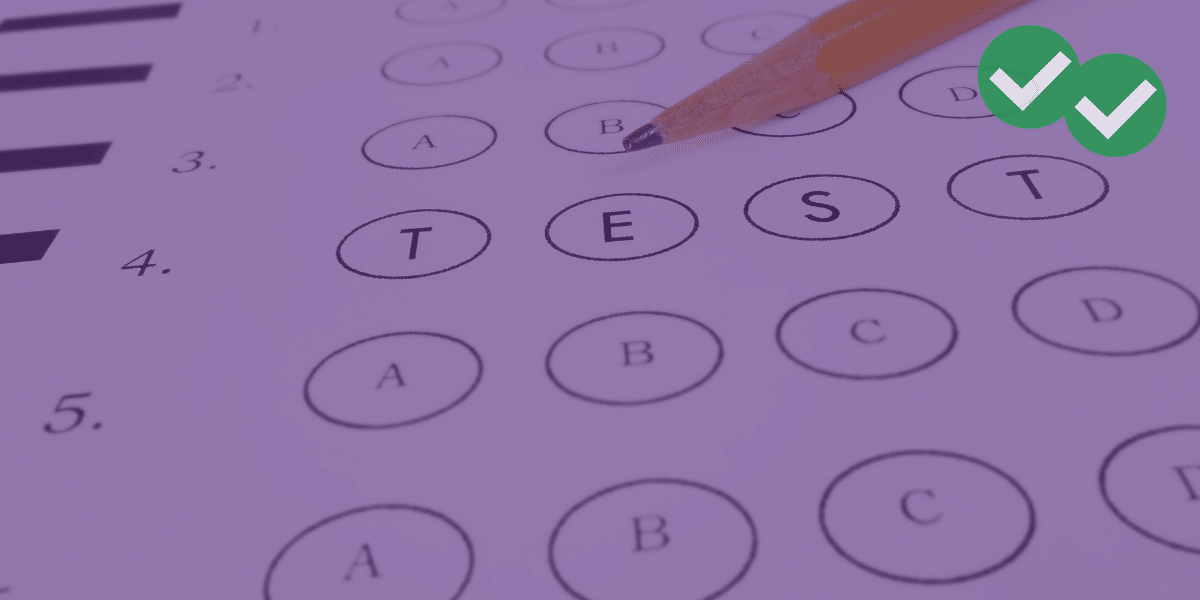
This post was updated in 2024 for the new GMAT.
Take the GMAT Diagnostic
Curious about where you would stack up compared to others taking the GMAT test? Take our free GMAT Diagnostic Quiz (with questions from all three sections: Quantitative, Verbal, and Data Insights) to gauge your skills on the GMAT exam:
At the end of the quiz, you can view text and video explanations for every question. Plus, continue reading here for advice on how to study next based on your results!
What You Need to Know about the GMAT Diagnostic Quiz
But first, let’s go over some important information about the free GMAT Diagnostic Quiz. It’s 20 questions long, and we recommend that you set aside 45 minutes to take it. Here’s a more detailed breakdown:
- Quantitative Reasoning – 7 questions
- Verbal Reasoning – 7 questions
- Data Insights – 6 questions
This quiz is roughly one third of a full GMAT exam. However, unlike the real GMAT, this quiz is NOT adaptive. On the actual GMAT, future questions you encounter will become harder/easier based on your performance on previous questions. In this quiz, you’ll see a preset range of difficulties (from Easy to Very Hard) and a sampling of various question types. For a true adaptive experience, an estimated GMAT score, and a more accurate measure of your abilities, we highly recommend that you take a full-length practice test.
If you are brand new to the GMAT, it’s a good idea to get familiar with the various question formats first. You can learn about the GMAT “big picture” (question formats, topics, pacing, etc…) in Magoosh’s What is the GMAT? Everything You Need to Know article or in the GMAT Official Guide created by GMAC, the test-makers of the GMAT.
Your GMAT Diagnostic Quiz Results and What to Study Next
Once you’ve taken the GMAT diagnostic quiz, you’ll get your overall score out of 20 and will be able to see your results on each individual question. The study recommendations here are for an individual section (Quant, Verbal, or Data Insights), so tally up the number of questions you answered correctly in each section first before reading the advice.
By the way, don’t be discouraged if you found the quiz difficult: the GMAT is supposed to be hard! Keep in mind that this is just a diagnostic to measure where you are in your GMAT journey. Use this tool as a gauge of your current level and not an absolute measure of your abilities.
No matter how you scored, we strongly recommend that you follow a study schedule. We generally recommend that students study for at least three months, but there are shorter and longer schedules available. In the advice below, there are some additional suggestions around study schedules, but for even more detailed suggestions, check out the study schedules themselves.
Section Score: 0 – 1 Right Answers
Many folks preparing for the GMAT test will fall into this group, including most people who are at the very beginning stages of their studying. And that’s perfectly fine! Yes, this is the “lowest” of the four groups in terms of Diagnostic GMAT scores, but this does NOT mean you are starting with any kind of disadvantage. I will emphasize that it is quite possible to start with these recommendations and get a 705+ score on the GMAT test. It all depends on your commitment to excellence.
Your results suggest that you need to learn academic material and not just go through practice sets. Many students make the disastrous pedagogical mistake of binging on questions and ignoring lessons. Watch the lessons! And watch the answer explanations under the questions you miss; these are essentially mini-lessons.
With that in mind, we recommend that you closely follow a study schedule to ensure that you’re both learning the foundational material you need as well as putting it into practice.
Section Score: 2 – 3 Right Answers
This, too, is a common scoring range to be in when starting out in your GMAT prep, so don’t worry if you find yourself here. Landing in this range on the GMAT diagnostic quiz simply means that you’ve identified areas for improvement. And the good news is that you have plenty of room to grow your score. Take note of the question types and subjects that you missed on the diagnostic, and plan to focus on improving in those areas.
Results in this scoring range also suggest that you can pick up a lot of points by prioritizing lessons to gain a strong grasp of fundamental concepts. On Magoosh, questions have a Related Lessons section beneath their explanations. If an approach is not making sense, it’s a good idea to review those lessons to ensure that you understand core strategies and concepts.
Therefore, following a study schedule closely is a good strategy here as well. This way, you’re sure to get a good mix of lessons and practice in your studies.
Section Score: 4 – 5 Right Answers
You have a pretty solid grasp of both GMAT question formats and concepts tested. However, keep in mind that these diagnostic quiz questions are just a small sampling of the GMAT. They also do not reflect the GMAT’s adaptive nature. You’ll need to sustain this performance on more questions and harder questions, so continued practice in your studies is essential. Additionally, landing in this scoring range means that there’s still room to improve, so you you can push your score even higher!
You have a bit more flexibility in how to approach your studies. When following a study schedule, you can be a bit more choosy in the tasks that you complete. For example, you likely already have a good understanding of some lessons’ content. Thus, you could view the summary of a lesson first to see if the lesson is something that’s already familiar to you or not. Likewise, you could jump straight into a lesson quiz to gauge your knowledge before viewing a lesson. But don’t neglect this resource! If you don’t have full understanding of a topic, these are well worth your time.
Lastly, you may want to do more targeted practice of the question types and topics that you struggle with the most. That’s where you’ll pick up the most points towards your overall score. But don’t neglect keeping your skills sharp in areas that you’re already doing well in. And since the GMAT itself is a mix of questions types and topics, practicing in the same manner is crucial.
Section Score: 6 – 7 Right Answers
If you are in this group, then congratulations! You already have shown tremendous progress toward impressive GMAT scores. Now, having said that, I will caution you: getting complacent is the best way to fall short of your potential. So many people get to this point and then lose a sense of urgency. This is precisely why so few wind up with scores over 645. Even though your prospects are good, the worst thing you could do would be to take anything for granted. In order to score high on all three sections, you still have to hunger for excellence. You still have to apply the habits of excellence assiduously.
Challenge yourself to push to deeper and deeper levels of understanding of GMAT concepts. One of the best ways to do this is to put yourself into a situation in which you have to explain a problem to someone else. It is one level of understanding to known how to do a problem and be able to do it cold. It is a higher level if you can walk someone who is confused through the problem step by step, answering all their questions so the problem makes complete sense to them. You really have to understand something deeply to teach it, and this is the kind of deep understanding that can get you a top GMAT score.
Closing Thoughts
Use this free GMAT Diagnostic Quiz as a springboard towards GMAT excellence. Again, for the most accurate assessment of where you currently stand, be sure to take a full-length practice test.
And with even more practice tests, lessons, questions, and explanations, Magoosh GMAT is a great way for you to learn and prepare for the GMAT exam. Get a year of access with Premium, or try us for free first with a 1-week trial!





Leave a Reply